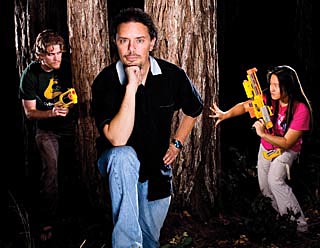According to Michael Mateas, we're on the brink of a revolution.
Mateas, associate professor of computer science and a lead faculty member in UCSC's hot new computer game design program, predicts that the interactive structure of computer gaming will soon transform media as diverse as movies, visual art, fiction, documentaries, teaching materials, and even advertising.
Fortunately, Mateas isn't envisioning the still somewhat wooden characters and simple plots that characterize today's blockbuster games. UCSC's young, dynamic game design faculty are shaping the next wave of "computational media" through research into artificial intelligence, complex "player-driven" story structures, and ways to express a player's unique aesthetic sense.
UCSC's new undergraduate game design major, established in fall 2006 in the Jack Baskin School of Engineering, is helping fuel this revolution. Computer game design integrates UCSC's strong programs in computer science and the digital arts; it's one of the fastest growing majors on campus, with more than 200 students in fall 2008.
"This is already one of the top three computer game design programs in the country because we were able to build on great existing programs, as well as make some fantastic faculty hires," said Mateas, one of four core game design faculty in the Computer Science Department. "At UCSC, the faculty teaching undergraduate courses are actually creating the future of gaming through our research."
| Related story: Sony's unexpected gift |
Mateas is considered a pioneer for his work as codeveloper of Façade, hailed as the first in a new genre. The Façade "player" interacts with a troubled couple, Grace and Trip, and has a role in the fate of their marriage. The game flows so naturally that it's hard to remember the theoretical and computational complexity behind such believable interactions.
Mateas said he came to academia from the computer industry because it offered him more scope to mesh computer science with artistic expression, and because it gives him the opportunity to teach.
"Academia offers the freedom to really think about the future of computational media," he said, "and it's wonderful to help students invent that future."
This story ran in the Winter 2008-09 issue of the UCSC Review magazine.



